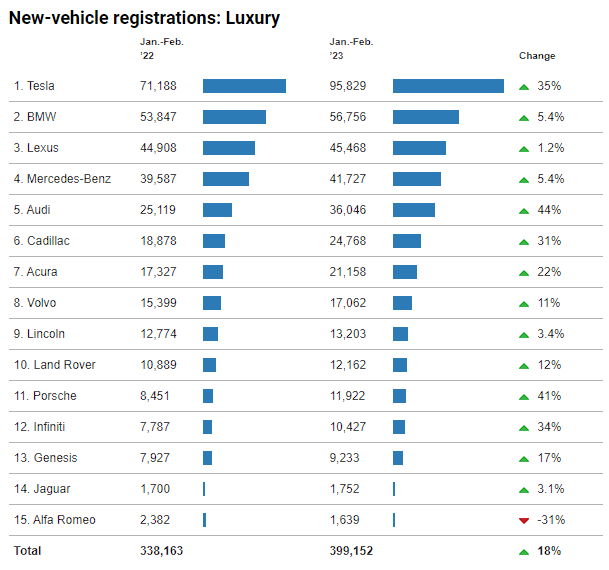Tesla Sales Growth Slows Despite Price Cuts (PDF)
According to new vehicle registration data, Tesla’s growth rate has slowed down in January and February 2023. Tesla’s share of the electric vehicle (EV) market dropped sharply in 2022 despite the automaker’s price cuts and the US government’s new round of federal tax incentives favoring American-made vehicles. In the first two months of 2023, Tesla had 95,829 new US registrations, a 35% increase from January-February 2022 but just a 3.7% increase from November and December 2022. The automaker’s deepest price cuts occurred in mid-January.
Tesla’s EV market share decreased from 72% to 58% in the January-February period of 2023. Meanwhile, non-Tesla new EV registrations increased by 151%, with Chevrolet and Volkswagen experiencing growth in their market share due to increased production of more affordable EV models such as the Chevy Bolt and VW ID4. In the first two months of the year, Chevrolet, the second-largest EV brand in the US, accounted for 8.5% of new registrations, while Ford, in third place, had 6.4%.
Still, Tesla remains the undisputed leader in the EV market despite the recent drop in market share. Even with a 58% share, Tesla still maintains a significant lead over its competitors. However, relying on price cuts may not be a sustainable solution, warns Karl Brauer, Executive Analyst at iSeeCars.com. Brauer explains that no automaker has ever resolved its issues solely by reducing prices, and such tactics may even harm the brand in the long run. Furthermore, with the arrival of new EVs in showrooms every month, Tesla’s traditional status as the only high-end EV option has now transitioned to a more crowded market.
| Top 10 EV Brands by Registration | |||
| Rank | Automaker | Jan-Feb 2023 | Jan-Feb 2022 |
| 1 | Tesla | 95,829 | 71,188 |
| 2 | Chevrolet | 13,919 | 92 |
| 3 | Ford | 10,610 | 4,921 |
| 4 | Volkswagen | 7,151 | 2,041 |
| 5 | Hyundai | 5,105 | 3,999 |
| 6 | Rivian | 4,295 | 321 |
| 7 | Kia | 4,238 | 4,623 |
| 8 | BMW | 4,092 | 116 |
| 9 | Mercedes-Benz | 4,004 | 1,248 |
| 10 | Nissan | 2,822 | 2,868 |
Elon Musk, the CEO of Tesla, has resorted to reducing prices in a bid to achieve 50% global sales growth in 2023 due to softening demand. While Musk has attributed the slower sales growth to higher interest rates, he has also recognized the importance of making Tesla’s vehicles more accessible to lure new customers. Competitors are keeping pace with Tesla’s driving-assistance technology and introducing newer model designs. Meanwhile, although Tesla is still working on its Cybertruck, rival automakers have already released three electric pickup trucks for sale.
Tesla’s Recent Price Cuts Pay Off for Some Models
The company’s recent price reductions have paid off for certain models. The Model Y crossover, for instance, received a 20% price cut in January and its registrations surged to 57,583 during January and February – a 71% increase from the same period last year. In fact, the Model Y was the most popular EV in the US by a wide margin. Similarly, the Model 3 sedan, which saw a more modest price cut, experienced a 15% increase in registrations with 32,411 in the same period. The Model X crossover had 4,332 registrations, a 62% rise, while the Model S had a sharp decline with registrations falling by 78% to 1,503.
Tesla’s price cuts have received positive reviews from Wall Street analysts, who have praised the company’s strategy of lowering prices to increase sales volume. Investment firm Baird has reaffirmed its optimistic outlook on Tesla, stating that the company will be able to maintain its position as a leader in operating margins and is better positioned than other automakers to weather economic challenges.


